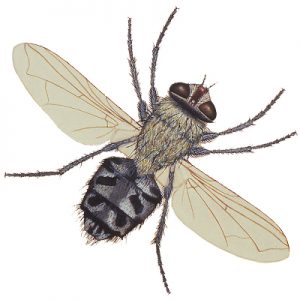Scientific Name: Pollenia
Common Names: Cluster Fly
Color: Non-metallic gray with golden hairs
Size: 5/16 inch long
FACT: Cluster flies are not related to livestock production. They do not develop in manure or manure pits. They are not interested in food, do not develop in garbage and are not a sign of unsanitary conditions.
HABITS
The adult cluster fly is 5/16- inch long, slightly larger than a common house fly. It is non-metallic gray in color with golden hairs on its thorax. When it lands on a surface, it folds its wings one on top of the other flat over its back. Cluster flies are slightly larger and darker than house flies and have a coating of short golden hair on their thorax. Cluster fly larvae look like typical maggots, but are seldom seen because they spend their lives as parasites inside earthworms.
- Feeding: Cluster flies do not eat garbage, manure, and show no interest in food, instead they feed on the nectar from flowers.
- Hibernation: Most of the flies spend the winter in protected locations such as attics or rooftops. Cluster flies are usually a greater problem in rural and suburban areas due to the large grassy areas that favour high earthworm populations. Overwintering adult Cluster flies are an annual problem in many houses. In late summer and fall, when the weather turns cool, cluster flies may congregate on sunny walls. They enter the home to overwinter through any available access. On warm, sunny days in the winter and spring, the flies often emerge from their hiding place and swarm on windows causing great annoyance by their buzzing and by their presence.
- Nesting: In the home, the flies hide, often in a cluster in attics and walls voids, in dark corners, cracks, under clothing in closets, beneath curtains, behind pictures and furniture etc.
- Reproduction: In April, Cluster flies lay their eggs in cracks in the soil. During the summer, the eggs hatch and the emerging larvae (maggots) penetrate earthworms and develop as a parasite in its host. There are several generations during the summer. The adults stop egg laying in late August and September and seek hiding places in which to overwinter.
CONTROL
To prevent the entry of the flies in the fall, screen attics and roof vents and fill all cracks, crevices and other points of entry with caulking or other crack filler. Tighten baseboards and quarter round. The target stage for control of most fly pests is the larval stage, when control is based on elimination of breeding material. But, because cluster fly larvae are parasitic on earthworms, and earthworms are an important part of the soil fauna, the larval stage of the cluster fly is not a practical target for control. The only feasible control methods for cluster flies center around keeping the adults out of house and killing those that do manage to get inside. Inspect the sides of your house for cracks and try to determine where the cracks lead, thereby locating the voids where the flies may overwinter. Treat the voids with an insecticide dust. An appropriately labelled pesticide applied to entry points on the sunlit sides of the house in late summer or early fall may be effective. This application is made before the flies begin their search for overwintering spots in order to kill flies as they attempt to enter. Flies found on the windows can be killed with a fly swatter and removed with a vacuum cleaner. Insecticides registered for indoor control of flies can be applied between inner and storm windows or directly on insects or if there is a window present, a cluster buster can be used. If no window is present an insect light trap can also be used.
If you are dealing with cluster flies in your home and need assistance, contact Poulin’s today. We have seven locations across western Canada in: Winnipeg, Brandon, Saskatoon, Regina, Calgary, Edmonton, and Lethbridge.

